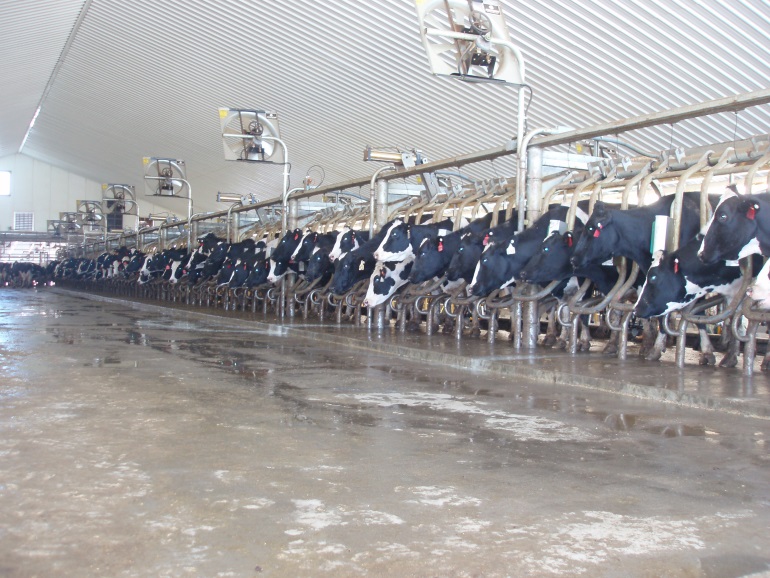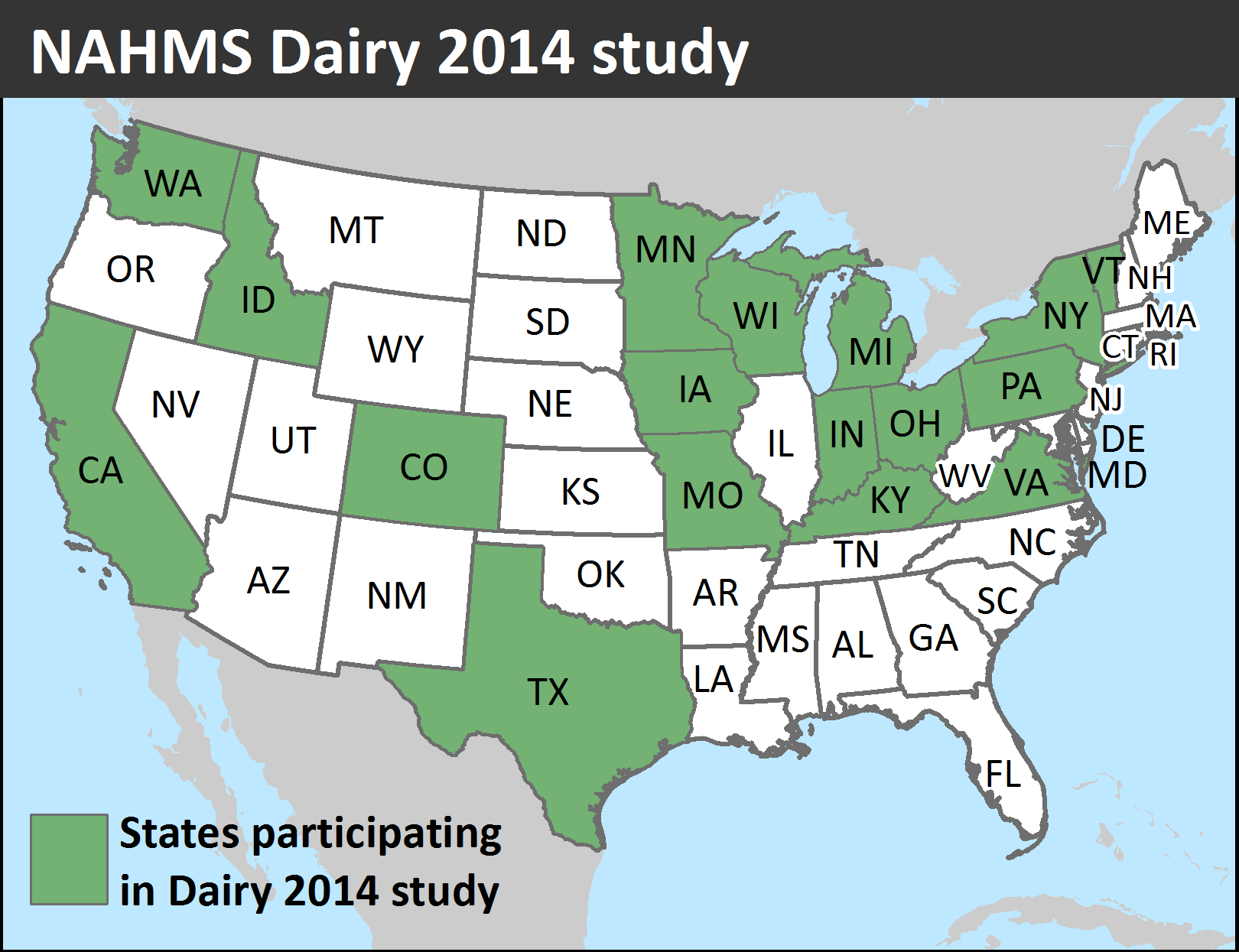NAHMS Dairy Launch Information Sheet
NAHMS dairy launch info sheet.docx
National Animal Health Monitoring System; Dairy 2014 Study
NAHMS Dairy Launch Information Sheet
OMB: 0579-0205


NAHMS Dairy 2014 Study
 In
January 2014, the USDA’s National Animal Health Monitoring
System (NAHMS) will launch its fifth national dairy study. Dairy
2014 will take an in-depth look at U.S. dairy operations, and
provide the industry with new and valuable information regarding
trends in the dairy industry from 1991 to 2014.
In
January 2014, the USDA’s National Animal Health Monitoring
System (NAHMS) will launch its fifth national dairy study. Dairy
2014 will take an in-depth look at U.S. dairy operations, and
provide the industry with new and valuable information regarding
trends in the dairy industry from 1991 to 2014.
Study focus
For the study, NAHMS asked dairy producers, industry stakeholders, and government officials to provide input and define the information needs of the dairy industry. During this process, six study objectives were identified:
Describe trends in dairy cattle health and management practices.
Describe management practices and production measures related to animal welfare.
Estimate the prevalence of lameness, and evaluate housing and management factors associated with lameness.
Evaluate calf health from birth to weaning.
Describe antibiotic use and residue prevention methods used to ensure milk and meat quality.
Estimate the prevalence and antimicrobial resistance patterns of select foodborne pathogens.
“The
NAHMS process for many years identified industry benchmarks that
provided a snapshot of industry practices that other producers
could use to see where they stand relative to their peers. The
NAHMS 2014 dairy study provides an opportunity for today's
producers to be part of this proud process. We encourage dairymen
to participate in this new study, and we look forward to being part
of the team that describes the emerging trends and identifies
opportunities for years to come.” —Dr.
Cassandra Tucker Department
of Animal Science University
of California, Davis —Drs.
Dan Weary and Nina von Keyserlingk Animal
Welfare Program University
of British Columbia, Canada
![]()
June 2013
June 2013
What your participation involves
In January 2014, representatives from the USDA’s National Agricultural Statistics Service (NASS) will contact selected producers in 17 States. NASS representatives will conduct personal interviews with all participating operations with 30 or more cows. NASS will mail a brief questionnaire to all other participating operations (fewer than 30 cows). Operations that do not respond to the mail-in questionnaire by the deadline will be contacted via telephone by NASS representatives, who will complete the questionnaire at that time.
For operations that are eligible and choose to continue in the study:
Representatives from USDA’s Veterinary Services will visit from March to May 2014 to administer a second questionnaire, perform a lameness evaluation, and collect milk and fecal samples.
A subset of these operations will have the opportunity to participate in a year-long calf-monitoring study.
“Our dairy farm participated in the last NAHMS dairy study and I was amazed at the data that was generated. I would urge all dairy producers to participate.”
—Velmar Green, dairy producer
Green Meadow Farms
“The
NAHMS 2014 dairy study focuses on key areas important to dairy
producers and consumers alike, including lameness, calf health,
animal welfare, and food safety. Current data collected from U.S.
dairy farms will be valuable to the dairy industry in establishing
benchmarks and opportunities. I encourage all dairy producers to
participate in this valuable study; it is a win-win situation for
the U.S. dairy industry.” —Dr.
Michael Hutjens Extension
Dairy Specialist Professor
Animal Sciences Emeritus University
of Illinois, Urbana

Participating producers will receive:
Customized reports describing animal welfare measures, heifer-calf growth and productivity, the risks of drug residues in meat and milk, and how to address these risks. Based on questionnaire responses, these reports will allow producers to compare their practices and productivity measures with those of other dairies. Best management practices/industry goals will also be included.
The opportunity to improve the health and productivity of heifer calves, from birth to weaning.
Reports and information sheets.
The dairy industry will benefit from:
Current and scientifically valid estimates of management practices, disease prevalence, and other information important for trade and the health of the dairy industry (e.g., benchmarking).
Trends in the implementation of management practices and the prevalence of foodborne pathogens.
“The
NAHMS Dairy 2014 study will provide valuable information for our
dairy industry, and for our dairy research scientists and advisors.
Information from NAHMS Dairy 2014 will help focus research efforts
and dollars on dairy animal health and well-being, as well as
biosecurity issues of most concern to dairy farmers across our
Nation. I hope all producers participating in this study realize
the importance of Dairy 2014 to our industry.” —Karen
Jordan, DVM Dairy
producer, Veterinarian Chair–Animal
Health and Welfare Committee of National Milk Producers Federation

A scientific approach
NAHMS collects and reports accurate and useful information on animal health and management in the United States. Since 1990, NAHMS has developed national estimates on disease prevalence and other factors related to the health of U.S. beef cattle, sheep, goat, dairy cattle, swine, equine, poultry, and catfish populations. The science-based results produced by NAHMS have proven to be of considerable value to the U.S. livestock, poultry, and aquaculture industries, as well as other animal health stakeholders.
NAHMS studies are
National in scope
Science based
Statistically valid
Collaborative
Voluntary
Confidential
Confidentiality
Because NAHMS studies rely on voluntary participation, the privacy of every participant is protected. Only those collecting the data know the identity of the respondent. No name or contact information will be associated with individual data, and no data will be reported in a way that could reveal the identity of a participant. Data are presented only in an aggregate manner.
____________________________
For more information, contact:
USDA–APHIS–VS–CEAH–NAHMS
NRRC Building B, M.S. 2E7
2150 Centre Avenue
Fort Collins, CO 80526-8117
970.494.7000
Or visit NAHMS at http://nahms.aphis.usda.gov
#679.0613
____________________________________
The U.S. Department of Agriculture (USDA) prohibits discrimination in all its programs and activities on the basis of race, color, national origin, age, disability, and where applicable, sex, marital status, familial status, parental status, religion, sexual orientation, genetic information, political beliefs, reprisal, or because all or part of an individual’s income is derived from any public assistance program. (Not all prohibited bases apply to all programs.) Persons with disabilities who require alternative means for communication of program information (Braille, large print, audiotape, etc.) should contact USDA’s TARGET Center at (202) 720–2600 (voice and TDD). To file a complaint of discrimination, write to USDA, Director, Office of Civil Rights, 1400 Independence Avenue, S.W., Washington, D.C. 20250–9410, or call (800) 795–3272 (voice) or (202) 720–6382 (TDD). USDA is an equal opportunity provider and employer.
Photographs courtesy of Dr. Jason Lombard
______________________________________________________________________________________________
| File Type | application/vnd.openxmlformats-officedocument.wordprocessingml.document |
| Author | aberry |
| File Modified | 0000-00-00 |
| File Created | 2021-01-29 |
© 2025 OMB.report | Privacy Policy